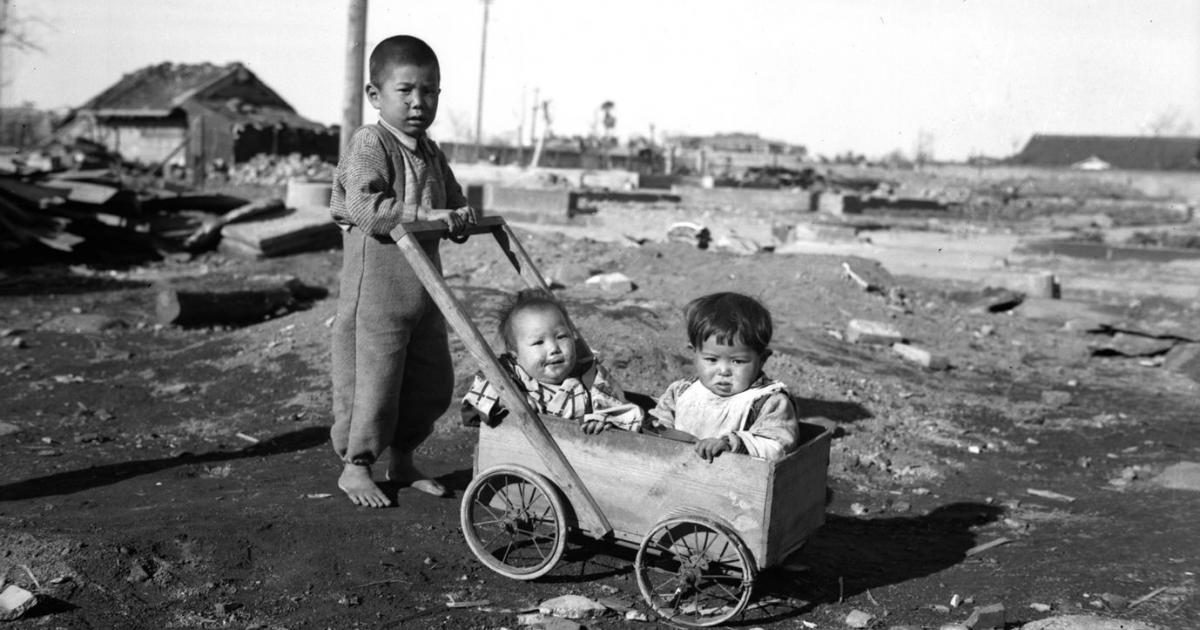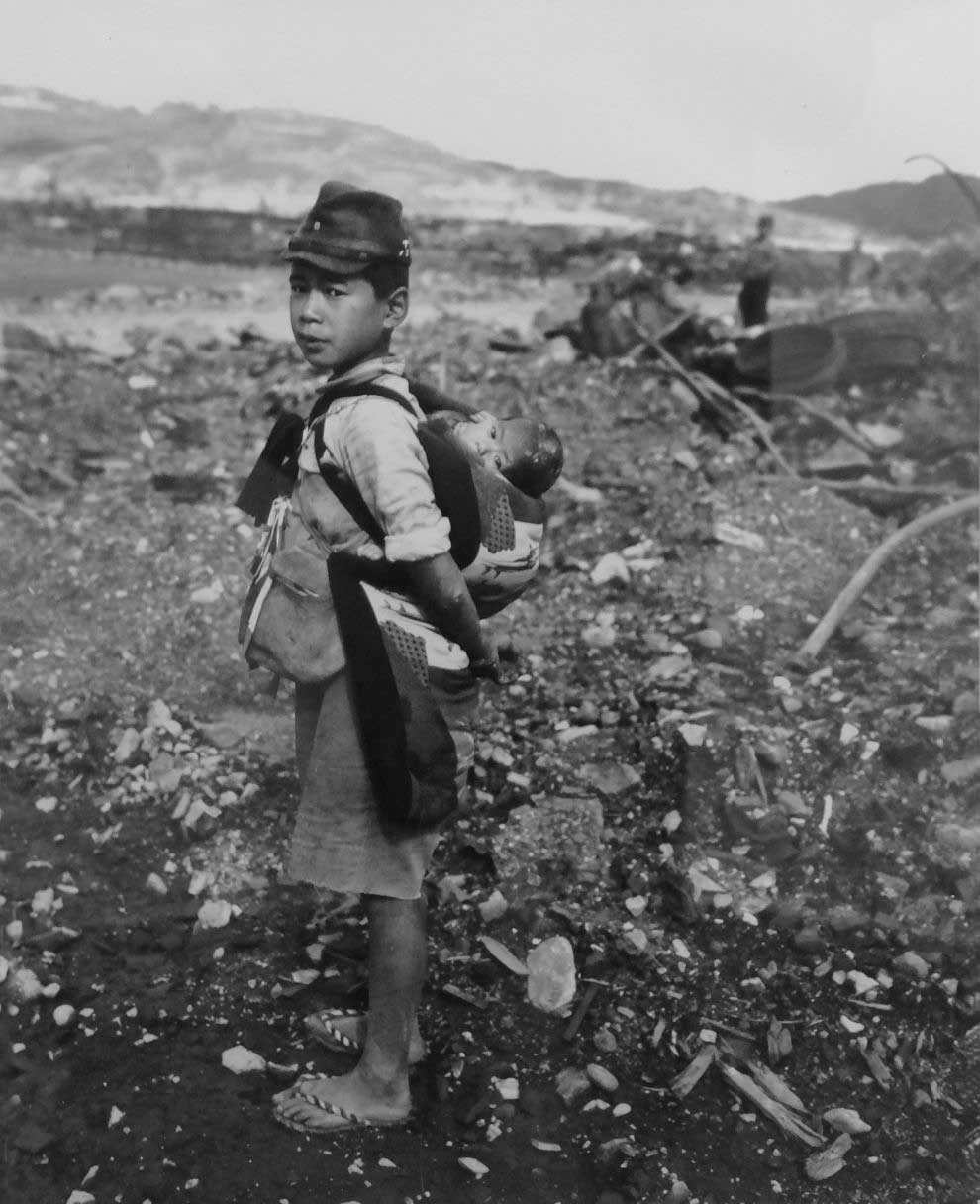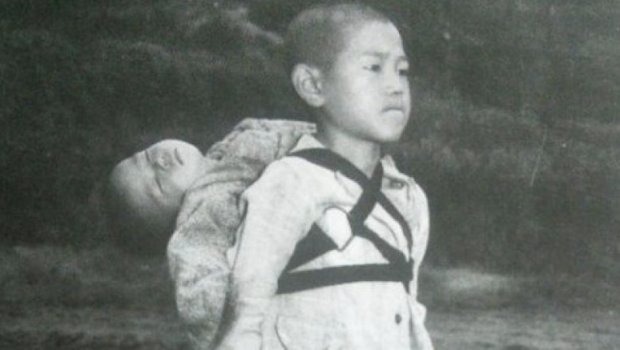Disclaimer: This article is presented for informational and educational purposes only. It is based on verified historical sources, including interviews with Joe O’Donnell, official archives, and museum records. The content is written from a neutral, nonpolitical perspective, with the goal of promoting understanding and remembrance.
In the final months of 1945, American photojournalist Joe O’Donnell was sent to Japan to document the aftermath of the atomic bombings in Hiroshima and Nagasaki. What he witnessed there would stay with him for the rest of his life. Amid the ruins, he captured one of the most haunting and humane images ever taken — the portrait of a young boy standing solemnly beside a cremation site, his deceased baby brother tied to his back.

A City in Ruins
When O’Donnell arrived in Nagasaki, the once-thriving port city had been reduced to ash and silence. Buildings were leveled, streets were scorched, and the air was thick with smoke and grief. Survivors moved through the devastation in a daze, searching for missing relatives or tending to the wounded. For O’Donnell, who had already covered the war in the Pacific, nothing could have prepared him for the scale of destruction he saw.
In his later interviews, O’Donnell described seeing children wandering alone, families gathered near the remnants of their homes, and long lines of people waiting for food or medical care. It was in this setting that he noticed a boy of about ten years old, barefoot and carrying something on his back — a bundle wrapped carefully in cloth.

A Moment of Silence
As the boy walked through the rubble, he approached a cremation site managed by relief workers wearing white masks. He stood quietly, waiting for several minutes. To O’Donnell, it appeared as if the child were patiently waiting his turn, much like others waiting for food or water.
But when the men in masks came forward and gently untied the bundle from the boy’s back, O’Donnell realized that what he carried was not supplies or a sibling seeking warmth. It was his baby brother, who had died in the bombing’s aftermath.
The workers placed the small body on the pyre with care and respect. The boy did not speak, move, or cry. He stood perfectly still, biting his lower lip, his face set in an expression of quiet endurance. O’Donnell noticed that the boy’s lip began to bleed slightly, yet he remained motionless — a gesture of discipline and sorrow far beyond his years.
O’Donnell lifted his camera and took a single photograph — an image that would later be known around the world as The Standing Boy of Nagasaki.

The Photograph That Spoke Without Words
The photograph captured no explosion, no battlefield, no soldiers. Yet it revealed the true aftermath of war: a child, forced to say goodbye in silence. For O’Donnell, this moment became the most unforgettable of his career. He later said that he had taken thousands of photographs in Japan, but none affected him as deeply as that single frame.
Years afterward, he recalled that he could not look at his negatives for decades. The memories were too painful. It wasn’t until the 1990s that he began publicly exhibiting his work from Hiroshima and Nagasaki, using them as a tool for remembrance and peace education.
“The boy stood straight and tall, like a soldier,” O’Donnell once said in an interview. “He was holding back his tears. When the flames consumed what he loved most, he simply turned and walked away.”
A Legacy of Memory
The identity of the boy in the photograph remains unknown. No record has ever confirmed what became of him after the war — whether he survived radiation illness or lived to adulthood. Yet his image has come to symbolize the innocent victims of war and the resilience of those left behind.
O’Donnell’s photo has been displayed in peace museums in Japan and featured in exhibitions around the world, including the Nagasaki Atomic Bomb Museum. Visitors often describe it as one of the most emotionally powerful images they have ever seen.

Beyond Statistics — Remembering the Human Cost
Historians estimate that approximately 70,000 people were killed instantly when the atomic bomb was dropped on Nagasaki on August 9, 1945, and tens of thousands more died in the following months from radiation-related illnesses. Among them were countless children.
O’Donnell’s photograph served as a reminder that behind every statistic and historical record are real people — families, children, and communities who suffered unimaginable loss. It showed that the cost of war is not only measured in military terms but also in the silent endurance of those too young to understand why it happened.
The Photographer’s Mission
Joe O’Donnell continued to work as a photographer for the U.S. government and major publications after World War II. However, his experiences in Japan never left him. In his later life, he became an advocate for peace, using his photographs as tools to educate future generations about the consequences of war.
He often explained that his purpose was not to assign blame or reopen historical wounds, but to encourage compassion and understanding. “I wanted people to see what I saw,” he said. “To remember that behind every war, there are children who lose everything.”
O’Donnell passed away in 2007 at the age of 85. His body of work, especially his Japan collection, remains a vital historical record of the human dimension of war.
A Universal Message
The image of the boy from Nagasaki transcends borders and generations. It continues to be shared in classrooms, documentaries, and museums as a symbol of strength and sorrow. The boy’s composure — standing alone amid ruin, refusing to cry — reflects not just personal loss, but the resilience of humanity itself.
In a world still troubled by conflict, O’Donnell’s photograph offers a silent plea: to remember the human faces behind every act of violence, and to build a future where no child must bear such grief again.
As O’Donnell’s exhibitions traveled around the world, audiences often left in silence — not because the image was graphic, but because it said so much without a single word. It reminded viewers that the most powerful images are not always those that show destruction, but those that show the strength to endure it.
Conclusion
The story of the boy from Nagasaki, as seen through Joe O’Donnell’s lens, remains one of the most poignant representations of the cost of war. It captures the moment when innocence met unimaginable loss — yet also the moment when humanity’s strength shone through despair.
Even though the boy’s name is unknown, his image continues to speak for all children affected by war. It asks the world to remember, to reflect, and to choose peace.
Sources:
-
U.S. National Archives – Photographs by Joe O’Donnell (1945–1946)
-
Nagasaki Atomic Bomb Museum official collection
-
Interview with Joe O’Donnell, Kyodo News, 1995
-
BBC News, “The Photograph That Tells the Story of Nagasaki’s Silent Boy,” 2017
-
Smithsonian Institution Archives – The Legacy of War Photography

